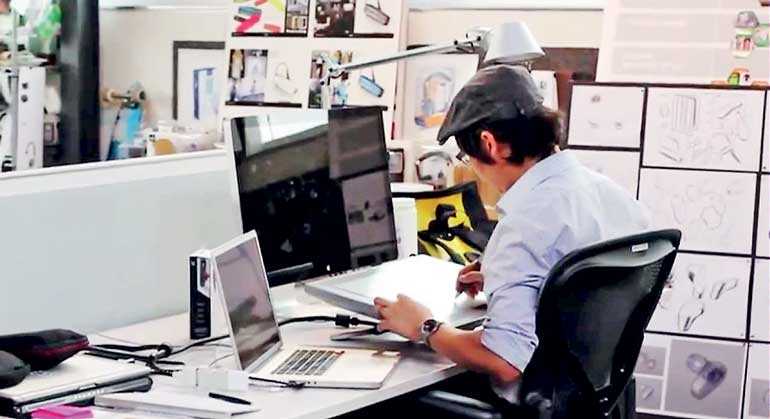Friday Mar 14, 2025
Friday Mar 14, 2025
Thursday, 26 April 2018 00:00 - - {{hitsCtrl.values.hits}}


Let me begin by stating a controversial opinion: our contemporary lives are defined by 200 years of dehumanisation.
From the time of the industrial revolution, the nature of work and labour has changed dramatically. The relationship between man and machine has always been tenuous, with machines being used to help man work faster, better, and more productively, yet causing existential angst for mankind. The rise of the machine and its intelligence, once driven by man, now threatens to replace and succeed men.
In response, almost as if to validate our own existence, we still continuously climb towards the horizon of perfection, striving to rid our outer world of disorder. The trajectory towards a future with driverless cars and artificial intelligence seems inevitable, and quite inviting.
In this journey of data-fication, quantification, objectification, the mode of being human is also changing. Elon Musk once famously proclaimed: “We are already cyborgs. Your phone and computer are extensions of you.”
In the most human of institutions, from the government, to schools, we see the same phenomena. The Chinese Government’s proposed system that connects citizens’ financial, social, political and legal credit ratings into one social trustability score, ultimately means a machine could control an individual’s social access to lifestyle rewards (and punishments).
Similarly, at school level, e-learning is celebrated and the role of the human teacher increasingly debated. Unsurprisingly then, in the space of the home, automation in the form of machines such as Rotimatic are now promising to replace the need for human involvement in mundane chores, freeing us up to pursue grander goals and to make better use of our time.
While some of these changes reflect how humans have harnessed technology and automation to reach the peak of solving for external problems, such as convenience and efficacy, we have paradoxically seen the rise of inner entropy. The rise of machine efficiency has matched the rise of mental health issues in young people, the phenomena of urban loneliness, and a slew of other emotionally complex challenges.
Ironically, as our external world neatens, we observe an increased articulation of unhappiness, disillusionment, and disconnection.
These emerging questions loom large with people asking louder and louder, both offline and online: What should my relationship with money be? How can I achieve well-being? Why and how should I consume? What does success mean?
Horst Rittel identified problems that are ill-defined and that have obscure solutions to be “wicked problems”. While wicked problems were originally defined in the context of social policy problems, these deeply existential questions of the modern world are equally complex and perhaps more difficult to solve, partly because of their intrinsically personal nature. They are the wickedest of the wicked problems.
Interestingly, these are also exactly the questions that machines cannot seem to solve. Although machines are able to ‘read’ emotion, possibly better than humans can, they have faced limitations at being able to solve the problems of social interaction and human behaviour, which are at the heart of human needs.
Most recently, researchers and writers such as Christian Madsbjerg have highlighted the limitations of the hard sciences in explaining non-linear, seemingly irrational human behaviour. Similarly, Goeff Colvin proposes that we ask, “Which of the activities that we humans, driven by our deepest nature or by the realities of daily life, will simply insist be performed by other humans, regardless of what computers can do?”
These all point to an increased focus, return to, and celebration of investigations of human-ness, which the field of the humanities has long done and continues to be equipped to do. In an “anesthetising world of algorithmic promise”, the yearning for that intersection between humanity and empathy grows stronger.
This chaotic modern narrative highlights the limited powers of the automated world, and the urgent need for a new design and way of thinking that taps onto an understanding of culture and humanity – a different weaving of science and magic – that has alchemy to solve for such complexity.
This turn to the ‘human’ has been best epitomised by the rise of Human-Centred Design (HCD) – a buzzword that no one can now ignore. However, the celebration of HCD has been matched equally by a rising criticism of it.
From the problem of scalability to lack of complexity, a most common complaint has been related to the lack of deep understanding that designers have of the human activity in their attempt to understand the human. In these criticisms, a competing contrast has been set up between activity-centred design, and human-centred design.
What this highlights is how current design discourse lacks depth to solve for the complex wicked problems of the world. However, the mistake here is in the framing of the solution: putting the human in the centre of design necessarily includes an examination of the activity in question – in real anthropological perspective, an in-depth focus on the human necessarily includes his ecosystem, and his activities.
Deep design is therefore a way of bringing about new clarity and order to a discourse on design that focuses on the human, but seems to lack empathy for human needs, the human ecosystem, and human activities.
Deep design is a marriage of cultural inquiry and the design-oriented mind, where the two share a symbiotic relationship that draws on, challenges, and extends the existing knowledge and skills that are key to each field. It balances deep human empathy with the engineering precision of design, bringing the two together in service of great – not just good – design.
One must tap meaningfully into culture through rigorous anthropological investigations that extend through space, time, and myths. Culture, as a shared understanding between communities, traditionally reflects the relationships between man’s inner psyche and his outer world and environment, and unlocks for us the mysterious ways in which meaning is created, understood, and shared between people.
Design, as our chosen process to order these patterns and meaning-systems in culture, has a single-minded focus to create clear and tangible solutions from this data. It re-imagines, re-frames, and re-orders the depths of what we glean from cultural understanding, bringing about the clarity necessary for problem- solving.
(The writer is Partner, Quantum Consumer Solutions.)
Discover Kapruka, the leading online shopping platform in Sri Lanka, where you can conveniently send Gifts and Flowers to your loved ones for any event including Valentine ’s Day. Explore a wide range of popular Shopping Categories on Kapruka, including Toys, Groceries, Electronics, Birthday Cakes, Fruits, Chocolates, Flower Bouquets, Clothing, Watches, Lingerie, Gift Sets and Jewellery. Also if you’re interested in selling with Kapruka, Partner Central by Kapruka is the best solution to start with. Moreover, through Kapruka Global Shop, you can also enjoy the convenience of purchasing products from renowned platforms like Amazon and eBay and have them delivered to Sri Lanka.
Discover Kapruka, the leading online shopping platform in Sri Lanka, where you can conveniently send Gifts and Flowers to your loved ones for any event including Valentine ’s Day. Explore a wide range of popular Shopping Categories on Kapruka, including Toys, Groceries, Electronics, Birthday Cakes, Fruits, Chocolates, Flower Bouquets, Clothing, Watches, Lingerie, Gift Sets and Jewellery. Also if you’re interested in selling with Kapruka, Partner Central by Kapruka is the best solution to start with. Moreover, through Kapruka Global Shop, you can also enjoy the convenience of purchasing products from renowned platforms like Amazon and eBay and have them delivered to Sri Lanka.